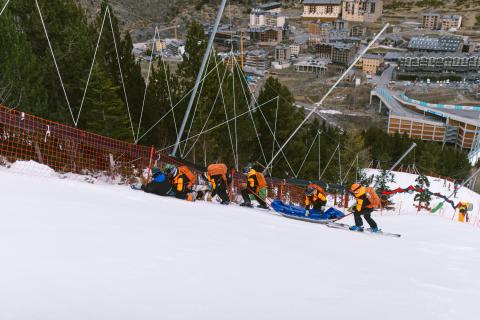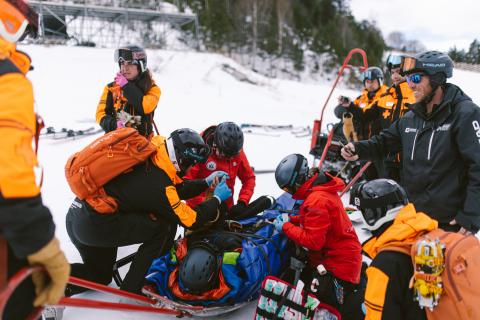This Tuesday, the Avet slope in the Soldeu sector of the Grandvalira ski station was the venue for a simulated accident evacuation drill. This was done to test the emergency response set-up that is in place for the Women's Alpine Ski World Cup that is going to be held on the 10th and 11th of February. Today’s drill was performed by around fifteen people from the different teams of specialists, although during the event a total of 30 people will be part of the emergency response team comprising of piste medical services, SUM, Civilian Protection and helicopter ambulance professionals. They will be coordinated by the heads of the different units, Laura Sánchez and Silvia Mandicó; Chief of Race, Santi López, and Deputy Head of Piste Rescue, Bibi Griera.
To be precise, the exercise was carried out on the last steep section (‘the wall’) of the Avet slope, one of the most demanding and challenging parts of the course. During the drill, it was possible to see that the first to intervene in an accident are the piste rescue team, who are those responsible for deciding whether to mobilise the medical teams, each comprising of a doctor and a nurse. The medical team, in turn, decides which evacuation resource is used depending on the severity of the racer’s injuries: via the slopes to the nearest medical centre in El Tarter or to the helicopter landing pad located in the car park in El Tarter. For serious cases, the helicopter transfer to the hospital would be carried out from there.
The Chief of Race, Santi López explained that this drill "is very important to be able to analyse and check all the processes and identify any possible errors and any areas for improvement for real life situations and to assist the skier with the utmost guarantees." The head of the medical unit, Laura Sanchez commented that "it is an opportunity to mobilise the teams, put them under pressure and build cohesion, so that any evacuations are done in a swift and efficient fashion." For her part, Bibi Griera, in charge of Piste Rescue, explained that the drill involved an injured skier with a tibial fracture and that the teams set to work evacuating the skier as quickly as possible, safely and following all the appropriate steps.
Safety and security unit led by Civilian Protection
The piste medical team is only one part of the extensive safety and security unit that the event will have in place. On one side, Red Cross volunteers will take care of any medical needs that any members of the public or people who will fill the stands might have. While away from the slopes there is a Civilian Protection Unit that will coordinate the many resources to guarantee road safety and public safety and will make sure that accesses and car parks are functioning perfectly. Members of the police, of the firefighting service, of the Roads Development and Conservation Entity (COEX), national park rangers, local traffic wardens and private security personnel will also participate.














